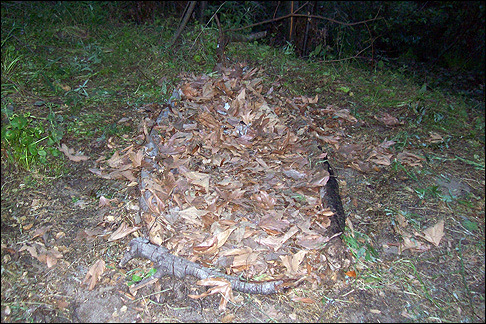
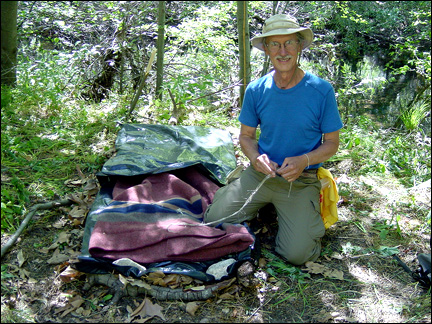
The next priority on every person's agenda was constructing a shelter before sunset. The shelter had to meet a major requirement, which was insulation from the cold ground at night. No rain was predicted during our trip. Each individual had an idea in mind before the trip started on what type of shelter to create.


A thick pile of dry leaves was contained by a border of dead branches to prevent heat loss from the ground. Plastic trash bags were laid on top of the leaves. The wool blanket was placed on the trash bags. Another trash bag enclosed the wool blanket at the foot end.
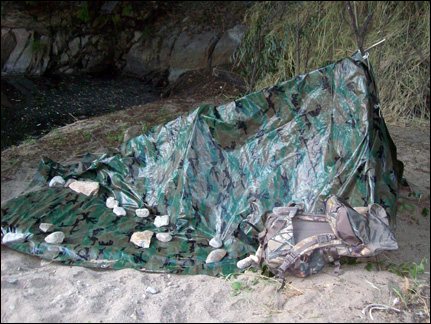
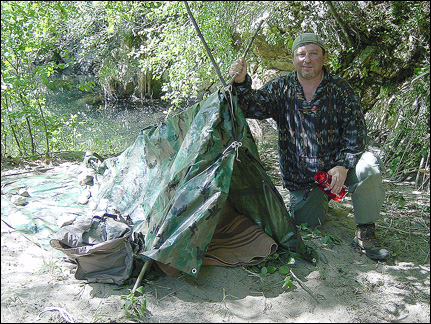
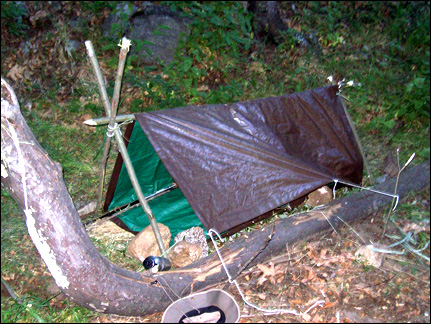
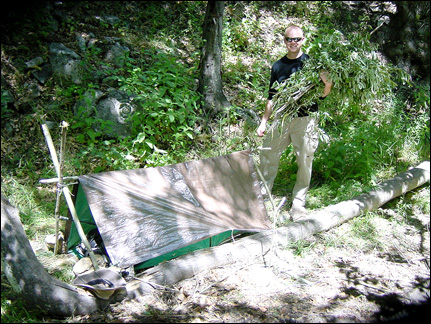
A-frame shelters were fashioned out of plastic tarp. Dry grass and small willow branches with foliage provided insulation from the cold ground.
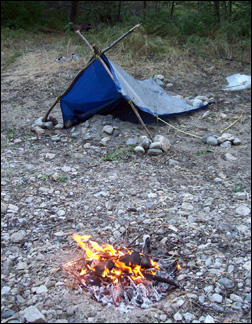
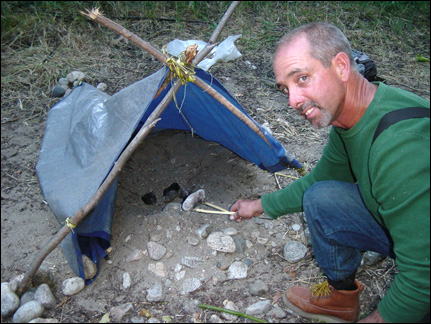
Rocks were heated in the fire and placed in a depression in the sand. The heated stones were covered with a layer of sand and the wool blanket was placed on top of the sand. The hot rocks radiated heat back to the sleeper, which kept him warm during the night. Eventually, the stones lost their warmth at the latter part of the night.
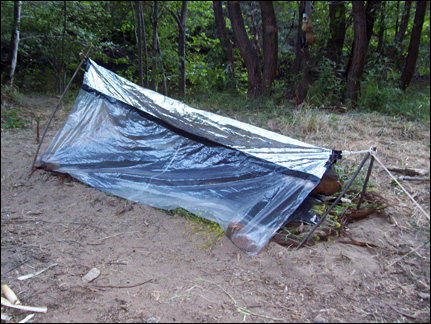
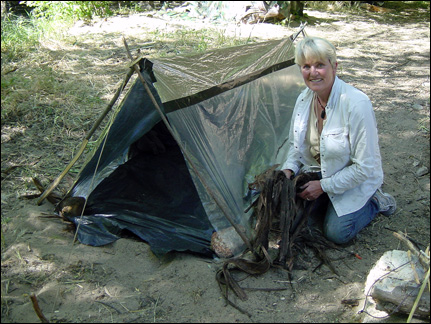
The shelter was made from a sheet of reflective mylar, a black garbage bag and a clear plastic trash bag, which were all taped together. The bags were split open to form a flat sheet of plastic. The reflective mylar formed one side of the A-frame shelter. The clear plastic bag formed the other side of the shelter. When a fire was built in front of the clear plastic side of the shelter, heat radiated into the enclosure. The mylar reflected the heat back into the shelter, which kept the inside warm for the night. Shredded bark from a dead cottonwood log and many cut stalks of non-native black mustard provided an insulating barrier from the cold ground.
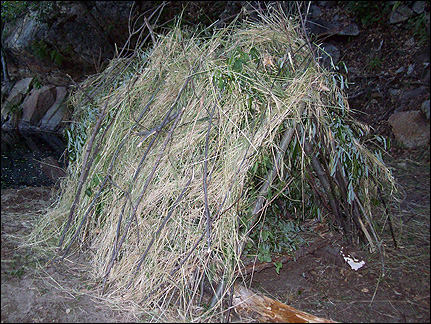
The shelter was made of dead logs and tree limbs, cut branches of willow and dry grass. A trough was excavated in the sand. Dead logs were placed on both sides of the trough and dry, sturdy limbs were laid side by side on the logs to form a bed for sleeping. A layer of willow branches created the sides of the shelter and a final layer of dry grass completed the exterior. A bedding of willow foliage lined the floor of the shelter. Large rocks were heated in the fire and rolled into the trough to radiate heat upwards into the primitive lodging.
After the shelters were built, the next task on the list was to prepare dinner before it got too dark. We decided to boil all of the edible plants we gathered to make a vegetarian soup. Some of the people took on the chore of preparing the cattail and the other food, others started boiling the water and the rest went out to gather more fire wood. Everyone participated in cooking the meal.
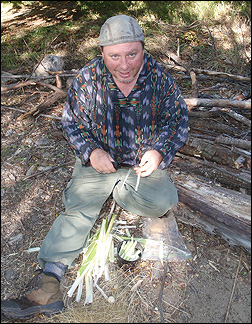
Preparing the cattail stems and shoots.
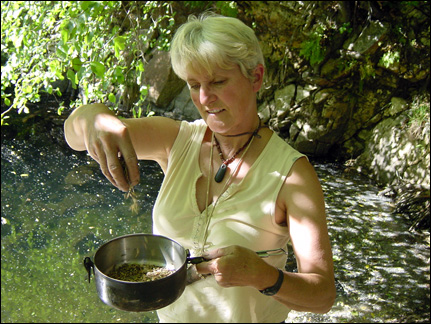
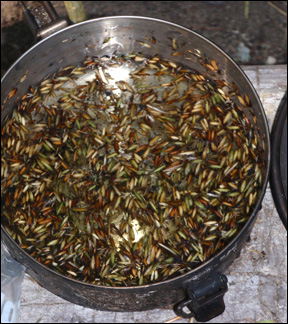
Processing the wild oat grains.
To prepare grass seeds for consumption, many California native groups lightly roasted or parched them in tightly woven winnowing baskets with live coals to enhance their flavor and remove the husks or chaff. Miguel Constanso described this process among the Chumash in summer 1769: "In order to eat the seeds, which they use in place of bread, they toast them first in great trays, putting among the seeds some pebbles or small stones heated until red. Then they move and shake the tray so it may not burn." The seeds were then skillfully tossed in the air in regular, even motions with a shallow basket, allowing any excess chaff to be carried off in the breeze. Further roasting of the cleaned seeds often intensified their flavor.
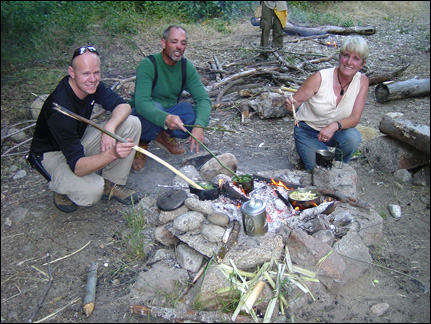
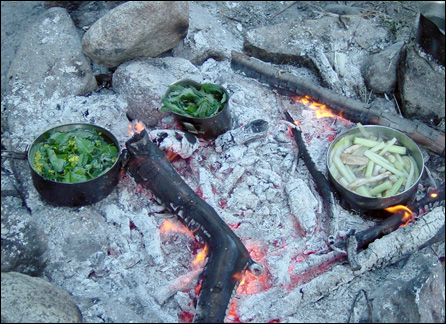
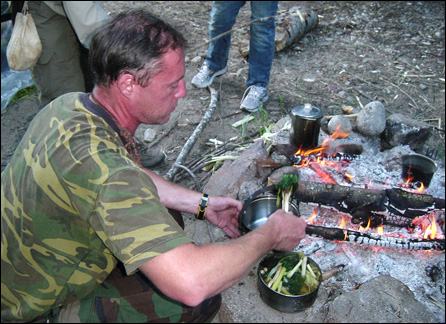
Dinner time!
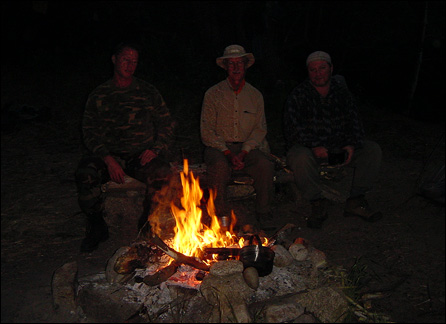
The sun dipped below the ridge as the cool night air wafted through our primitive camp. The flickering fire provided the comforting warmth that came from our own hands. We made fire, we gathered food and now it was time to settle in for the night in our own shelters to await the morning light.
"Try to rediscover everything: Know truth by your own direct experience."
"Knowledge is the key to survival."
Back to the Beginning of the Article
Read the conception about "Wilderness Survival Skills"
that started the adventure.
E-mail your comments to "Dino Labiste" at KahikoArts@yahoo.com
We hope the information on the PrimitiveWays website is both instructional and enjoyable. Understand that no warranty or guarantee is included. We expect adults to act responsibly and children to be supervised by a responsible adult. If you use the information on this site to create your own projects or if you try techniques described on PrimitiveWays, behave in accordance with applicable laws, and think about the sustainability of natural resources. Using tools or techniques described on PrimitiveWays can be dangerous with exposure to heavy, sharp or pointed objects, fire, stone tools and hazards present in outdoor settings. Without proper care and caution, or if done incorrectly, there is a risk of property damage, personal injury or even death. So, be advised: Anyone using any information provided on the PrimitiveWays website assumes responsibility for using proper care and caution to protect property, the life, health and safety of himself or herself and all others. He or she expressly assumes all risk of harm or damage to all persons or property proximately caused by the use of this information.
© PrimitiveWays 2013